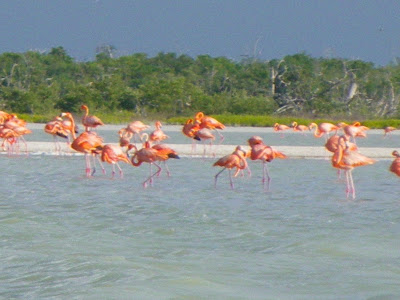
May 22nd, 2010
Alice and I are standing on the dikes of a huge salt works bordering Mexico's Reserva de la Biospera Ria Lagartos. We are looking at water that is incredibly salty and absolutely pink colored from small brine shrimp and other tiny carotene loaded organisms. Our guide, Roman Fernandez, scoops a handful to show us the pink orange squiggles thrashing about in the water. This is the food that makes the flamingos pink!
Fossil evidence shows us that 56 to 34 million years ago during the Eocene Epoch, the dawn of mammals, flamingos were wading about. Flamingos are gregarious birds in the genus Phoenicopterus and family Phoenicopteridae. Worldwide there are six different species. One of these, the American Flamingo, lives in the Caribbean with the greatest numbers in the Ria Lagartos Reserve area. And, when you see the huge population of wild flamingos there - sometimes there are as many as 40,000 in the reserve - they appear little changed from their early appearance on this earth. Gawky with their upside down looking bill yet incredibly graceful they glide across the vast flats of the reserve.
We had driven from Merida to Rio Lagartos on the coast of the Gulf of Mexico in the northern part of the the Yucatan. Once there we hired a guide to take us on on a birding adventure to view some of the hundreds of different species of birds that live or migrate through this reserve. We were not disappointed. Our guide, Roman, was a gifted naturalist well versed in the life histories and habits of the creatures we saw -birds and others. He filled us with such information as the size of the flamingos - 2.5 kilos for females, 5.5 kilos for males, that they may naturally live for 20 years, that they have few if any predators, that they lay and incaubate one egg per year, that they are white or green when young, and that they mate for life.
We had gone to Rio Lagartos , a fishing village of 3,000 inhabitants, to see the flamingos, but they were only part of the great show we experienced. Among the birds we saw in that afternoon were:
Thousands of Flamingos / Flamenco Comun
Great Blue Heron / La Gran Garza de Azule o Garzon Cenizo
Great Egret / Garzon Blanco
Boat-billed Heron
Boat-billed Heron / Garza CucharonSnowy Egret / Garzita Nivea
Great Black-hawk
Great Black-hawk / Aguililla Negra
Osprey / Gavilan Pescador
Feeding Wood Stork
Wood Stork / Ciguena
Roseate Spoonbill /Espatula
White Ibis / Ibis Blanco
Magnificent Frigate Bird / Fragata
Brown and White Pelicans
Brown Pelican / Alcatraz PardoWhite Pelican / Alcatraz Blanco
Neotropic Cormorant / Corvejon
Anhinga / Huizote
Ruddy Ground Dove / Tortilita Rojiza
Scaled Pigeon / Paloma Escamosa
Yucatan Parrot / Loro Yucateco
And many other birds.
Additionally we saw:
Crocodiles / Cocodrilos We saw several. One was huge and we saw it "up close"!! Roman said it was nesting. I later read that nesting crocodiles are most dangerous!












No comments:
Post a Comment